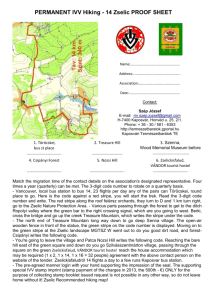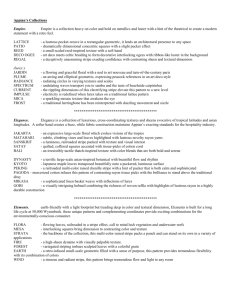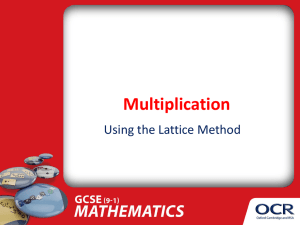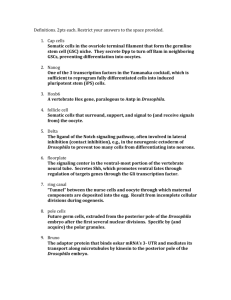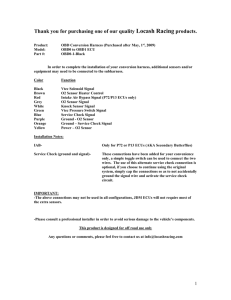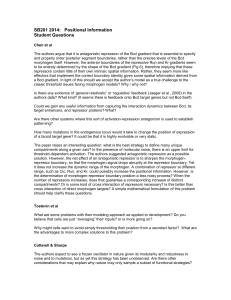The eve stripe 2 enhancer employs multiple modes
advertisement
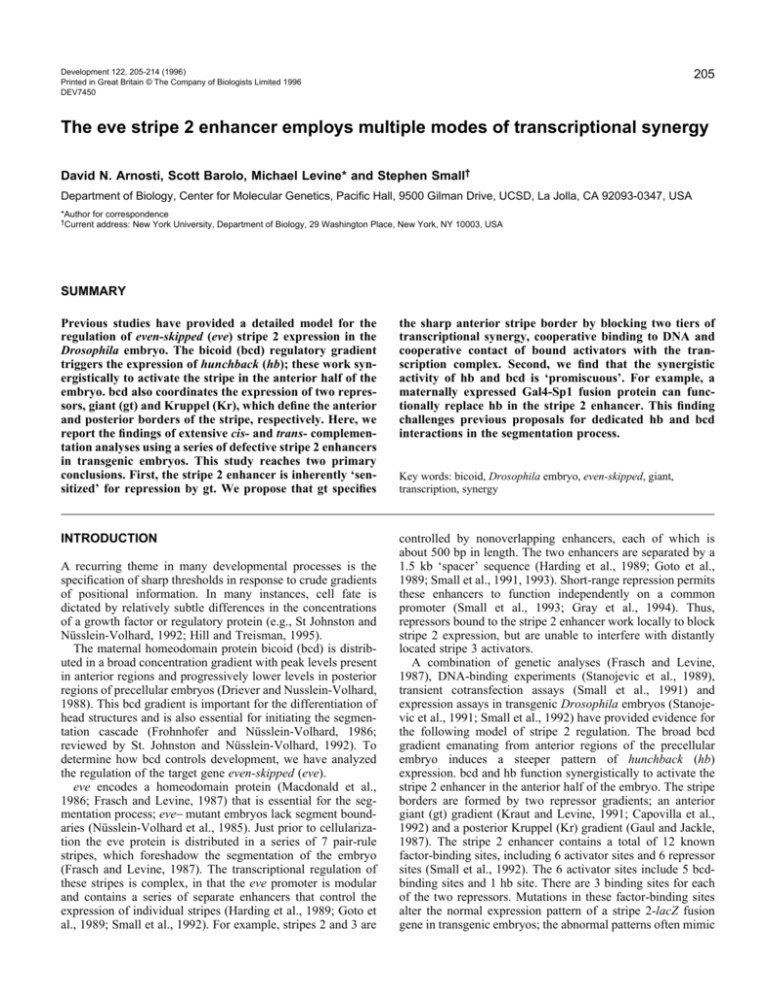
Development 122, 205-214 (1996) Printed in Great Britain © The Company of Biologists Limited 1996 DEV7450 205 The eve stripe 2 enhancer employs multiple modes of transcriptional synergy David N. Arnosti, Scott Barolo, Michael Levine* and Stephen Small† Department of Biology, Center for Molecular Genetics, Pacific Hall, 9500 Gilman Drive, UCSD, La Jolla, CA 92093-0347, USA *Author for correspondence †Current address: New York University, Department of Biology, 29 Washington Place, New York, NY 10003, USA SUMMARY Previous studies have provided a detailed model for the regulation of even-skipped (eve) stripe 2 expression in the Drosophila embryo. The bicoid (bcd) regulatory gradient triggers the expression of hunchback (hb); these work synergistically to activate the stripe in the anterior half of the embryo. bcd also coordinates the expression of two repressors, giant (gt) and Kruppel (Kr), which define the anterior and posterior borders of the stripe, respectively. Here, we report the findings of extensive cis- and trans- complementation analyses using a series of defective stripe 2 enhancers in transgenic embryos. This study reaches two primary conclusions. First, the stripe 2 enhancer is inherently ‘sensitized’ for repression by gt. We propose that gt specifies the sharp anterior stripe border by blocking two tiers of transcriptional synergy, cooperative binding to DNA and cooperative contact of bound activators with the transcription complex. Second, we find that the synergistic activity of hb and bcd is ‘promiscuous’. For example, a maternally expressed Gal4-Sp1 fusion protein can functionally replace hb in the stripe 2 enhancer. This finding challenges previous proposals for dedicated hb and bcd interactions in the segmentation process. INTRODUCTION controlled by nonoverlapping enhancers, each of which is about 500 bp in length. The two enhancers are separated by a 1.5 kb ‘spacer’ sequence (Harding et al., 1989; Goto et al., 1989; Small et al., 1991, 1993). Short-range repression permits these enhancers to function independently on a common promoter (Small et al., 1993; Gray et al., 1994). Thus, repressors bound to the stripe 2 enhancer work locally to block stripe 2 expression, but are unable to interfere with distantly located stripe 3 activators. A combination of genetic analyses (Frasch and Levine, 1987), DNA-binding experiments (Stanojevic et al., 1989), transient cotransfection assays (Small et al., 1991) and expression assays in transgenic Drosophila embryos (Stanojevic et al., 1991; Small et al., 1992) have provided evidence for the following model of stripe 2 regulation. The broad bcd gradient emanating from anterior regions of the precellular embryo induces a steeper pattern of hunchback (hb) expression. bcd and hb function synergistically to activate the stripe 2 enhancer in the anterior half of the embryo. The stripe borders are formed by two repressor gradients; an anterior giant (gt) gradient (Kraut and Levine, 1991; Capovilla et al., 1992) and a posterior Kruppel (Kr) gradient (Gaul and Jackle, 1987). The stripe 2 enhancer contains a total of 12 known factor-binding sites, including 6 activator sites and 6 repressor sites (Small et al., 1992). The 6 activator sites include 5 bcdbinding sites and 1 hb site. There are 3 binding sites for each of the two repressors. Mutations in these factor-binding sites alter the normal expression pattern of a stripe 2-lacZ fusion gene in transgenic embryos; the abnormal patterns often mimic A recurring theme in many developmental processes is the specification of sharp thresholds in response to crude gradients of positional information. In many instances, cell fate is dictated by relatively subtle differences in the concentrations of a growth factor or regulatory protein (e.g., St Johnston and Nüsslein-Volhard, 1992; Hill and Treisman, 1995). The maternal homeodomain protein bicoid (bcd) is distributed in a broad concentration gradient with peak levels present in anterior regions and progressively lower levels in posterior regions of precellular embryos (Driever and Nusslein-Volhard, 1988). This bcd gradient is important for the differentiation of head structures and is also essential for initiating the segmentation cascade (Frohnhofer and Nüsslein-Volhard, 1986; reviewed by St. Johnston and Nüsslein-Volhard, 1992). To determine how bcd controls development, we have analyzed the regulation of the target gene even-skipped (eve). eve encodes a homeodomain protein (Macdonald et al., 1986; Frasch and Levine, 1987) that is essential for the segmentation process; eve− mutant embryos lack segment boundaries (Nüsslein-Volhard et al., 1985). Just prior to cellularization the eve protein is distributed in a series of 7 pair-rule stripes, which foreshadow the segmentation of the embryo (Frasch and Levine, 1987). The transcriptional regulation of these stripes is complex, in that the eve promoter is modular and contains a series of separate enhancers that control the expression of individual stripes (Harding et al., 1989; Goto et al., 1989; Small et al., 1992). For example, stripes 2 and 3 are Key words: bicoid, Drosophila embryo, even-skipped, giant, transcription, synergy 206 D. N. Arnosti and others those seen when the wild-type stripe 2 enhancer is expressed tors, including bcd, a bcd-GCN4 fusion protein, or a Gal4-Sp1 in segmentation mutants (Stanojevic et al., 1991; Small et al., fusion protein. These results argue against the occurrence of 1992). dedicated interactions between bcd and hb proteins. Instead, it One of the most intriguing properties of the stripe 2 enhancer would appear that stripe 2 expression simply depends on a is that it generates a sharper expression pattern (a more refined critical number of generic transcriptional activators. These cell type-specific pattern) than the input regulatory gradients findings are consistent with recent studies showing that that form the stripe (e.g., Stanojevic et al., 1989; Small et al., activator synergy can involve multiple pathways to stimulate 1992). The present study investigates the basis for the specifitranscription. cation of the sharp anterior stripe border. In particular, how do small changes in the levels of the gt repressor form this border? In the present study, we show that defective stripe 2 MATERIALS AND METHODS enhancers lacking a crucial bcd activator site can be complemented by converting the low-affinity bcd-binding sites to Digital imaging of single and double-stained embryos optimal sites. Such enhancers can also be complemented in Embryos were stained for gt and eve protein using polyclonal antitrans by a strong transcriptional activator. These findings bodies and fluorescent secondary antibodies (Frasch and Levine, together with previous studies (Small et al., 1991, 1992) 1987; Kraut and Levine, 1991). Separate color channels representing gt and eve signals were analyzed digitally by scanning color slides at suggest that bcd is a weak activator and that stripe 2 expression is mediated by a series of weak binding sites. Previous studies have shown that the bcd gradient is severely limiting in the region of the embryo where stripe 2 is expressed. Thus, it would appear that the stripe 2 enhancer is inherently sensitized for repression by gt. We propose that gt establishes the sharp anterior stripe 2 border by blocking two tiers of transcriptional synergy, cooperative binding of bcd monomers and cooperative contact of the activators with the transcription complex. This study also investigates the nature of bcd-hb transcriptional synergy. Previous reports have emphasized the importance of these interactions in permitting the crude bcd gradient to establish sharp thresholds of target Fig. 1. gt might mediate repression via quenching. Transgenic embryos carrying different stripe 2-lacZ gene expression during the fusion genes are oriented with anterior to the left and dorsal up. The embryos were hybridized with a lacZ segmentation process. It has antisense RNA probe and visualized by immunohistochemical staining. All stainings were done in parallel been proposed that bcd and and the embryos are at a comparable stage of development (midpoint of nuclear cleavage cycle 14). hb might interact with (A) Expression pattern specified by the wild-type, 480 bp minimal stripe 2 enhancer. Previous studies distinct, rate-limiting compohave shown that this fusion gene is expressed exactly within the limits of the endogenous stripe 2. nents of the transcription Staining in anterior regions (on the dorsal surface in this embryo) is due to the P-element transformation complex (Small et al., 1991, vector (see Small et al., 1992). The diagram below the embryo shows the organization of the enhancer, which includes 5 bcd activator sites (B1-B5), 1 hb site (H3) and 3 binding sites for each of the two 1992). A similar mechanism repressors, gt (G1-G3) and Kr (K1-K3). The filled circles indicate high-affinity bcd-binding sites (B1 and has been implicated in B2), while the stippled circles are low-affinity sites (B3, B4 and B5). (B) Same as A except that mutations dorsoventral patterning by the were created in all 3 gt repressor sites (indicated by ‘X’). The anterior stripe border is not formed and the maternal dorsal regulatory staining pattern is derepressed in anterior regions. Expression does not extend to the anterior tip, possibly gradient and its partner, twist due to another, unknown, repressor (see Small et al., 1992). (C) Same as A except that mutations were (Szymanski and Levine, created in the central G2 gt repressor site. Although the G1 and G3 sites are intact, there is a substantial 1995). Here we show that a derepression of the pattern in anterior regions. The anterior expansion is not as severe as that observed in defective stripe 2 enhancer B, indicating that the G1 and G3 sites probably participate in the formation of the normal stripe border. lacking the hb-binding site (D) Same as A, except that the G1 and G3 sites were mutagenized. A nearly normal staining pattern is can be complemented by observed; there is some residual staining anterior to the stripe border. This result suggests that the central G2 site is nearly sufficient to form a normal stripe 2 border. various heterologous activa- even-skipped repression threshold high resolution and quantitating signals from individual cells using Adobe Photoshop and NIH Image Analysis software. Similar results were obtained by John Reinitz and Carlos Alonso, Mt. Sinai Medical Center, New York, by directly digitizing signals obtained from double-stained embryos using confocal microscopy (J. Reinitz, personal communication). Estimates of eve RNA were obtained by scanning in situ whole-mount stained embryos that were hybridized with antisense eve RNA or antisense lacZ RNA (for stripe 2 enhancer constructs) and stained as described in Small et al. (1992). Construction of eve-lacZ and effector P-element transposons All eve-lacZ fusion genes were made by cloning fragments from the eve promoter upstream of the unique PstI site of pEL1 (Small et al., 1992), which contains the eve basal promoter (to −42) fused to the lacZ gene. These promoter-lacZ fusions were cloned into the Pelement transformation vector CaSperR (Thummel et al., 1988) using the unique BamHI and XbaI sites. CaSpeR contains the white gene as a marker. Enhancers carrying Gal4-binding sites were made with an oligonucleotide bearing two Gal4 dimer-binding sites (Seipel et al., 1992) and containing ends complementary to the eve basal promoter (PstI) and to the 3′ end of the stripe 2 enhancer (BssHII). The oligonucleotide was inserted between a defective stripe 2 enhancer bearing a mutation in the H3 site (Small et al., 1992) and the basal promoter. The Gal4-Sp1 chimeric activator was constructed by fusing the coding regions for the Gal4 1-93 N-terminal domain to the glutamine-rich activation domain (amino acids 132-243) from Sp1 in pSCTEV (Seipel et al., 1992). A HindIII-XbaI fragment from pSCTEV-Sp1 containing a short leader and the coding region for this gene was linkered with NotI linkers and inserted into a NotI site of phsp83bcd3′UTR (Paul Szymanski). This expression vector was constructed using a 1.1 kbp KpnI-SacII fragment containing a fragment of the maternally active Drosophila hsp83 promoter (−880 to +150 bp, from pBSIIKS+ hsp83, Xiao and Lis, 1989) and a 900 bp SacIIXbaI fragment of the bcd 3′ UTR (obtained from pB304, G. Struhl). These fragments were ligated into pCaSpeR-AUG-βgal (Thummel et al., 1988) which had been cleaved with KpnI and XbaI to remove the lacZ gene. Fly stocks containing bcd-GCN4 chimeric activator proteins were obtained from Gary Struhl, Columbia University (Ronchi et al., 1993). Males carrying stripe 2-lacZ fusion genes were crossed to females carrying one or two copies of the bcd-GCN4 gene. Embryos from bcd-GCN4 line B312.3 are shown; similar results were obtained from line B314.2. The bcd-GCN4 activator gene contains two copies of the GCN4 acidic activation domain sequence inserted 282 bp 3′ of the bcd homeobox, and is expressed under the control of the bcd promoter. Mutagenesis of the even-skipped stripe 2 enhancer Individual binding sites were changed by oligonucleotide-directed mutagenesis using the Mutagene kit (Bio-Rad, CA) as described in Small et al. (1992). bcd-, hb- and gt-binding sites are identified using the nomenclature from Small et al. (1992). To alter existing bcdbinding sites towards the bcd concensus (Driever et al., 1989), the B3 site was changed from GCGATTATA to GGGATTAGG, the B4 site was changed from GAGATTATT to GGGATTAGC, and the B5 site was altered from CGGATTAAC to GGGATTAGG. New bcd sites were inserted between the H3 and B2-binding sites by use of mutagenic oligos (1)‘a’ 5′-CAAGGGATTGGGATTAGGATTGGGATCGGGC-3′ to insert the B1-like bcd-binding site GGGATTAGG 27 nucleotides 5′ of H3; (2) ‘b’ oligonucleotide 5′-GGGATCGGGCTAGGGATTAGGATTGGATTCCAAG-3′ to insert the B1-like bcdbinding site GGGATTAGG 51 nucleotides 5′ of H3. The gt 2 mutant was generated by deletion of 43 nucleotides using the mutagenic oligonucleotide described in Small et al. (1992). The gt 1,3 mutant was generated by reinserting the gt 2 site into the gt 1,2,3 deletion mutant described in Small et al. (1992). All mutagenized sites were verified by sequencing. 207 P-element transformation Promoter constructs were introduced into the Drosophila germline by injection as described in Small et al. (1992). yw67 flies were used for all injections and at least three lines were generated for each construct tested. Hybridizations using antisense lacZ probe were performed as previously described (Jiang et al., 1991). RESULTS Digital analysis of embryos stained with anti-gt and anti-eve antibodies (see Materials and methods) indicates that giant repressor levels are 2- to 4-fold lower in nuclei at the anterior border of stripe 2 than in anterior regions where the enhancer is inactive (data not shown). Quantitation of embryos stained to reveal stripe 2 transcripts suggest there may be greater than a 10-fold difference in the levels of eve RNA in the interstripe Fig. 2. Cis-complementation of a defective stripe 2 enhancer by removal of gt repressor sites. Embryos were stained and oriented as in Fig. 1. The diagrams beneath each embryo identifies mutagenized (‘X’) factor-binding sites. (A) Expression of the wild-type stripe 2 enhancer in a cellularizing embryo. The gap seen in ventrolateral regions is commonly seen (see Small et al., 1992). (B) Same as A, except that the high-affinity B1 bcd-binding site was mutagenized. There is a severe loss of expression of stripe 2. (C) Same as B, except that the three gt-binding sites were mutagenized (in addition to the B1 site). Expression is restored in a broad band in anterior regions where there are relatively high levels of the bcd activator. 208 D. N. Arnosti and others region (where eve is ‘off’) as compared with the anterior border of the stripe (data not shown). This quantitation is not rigorous and is only intended to provide a general sense of the problem (since the staining procedures are nonlinear). Nonetheless, it would appear that a modest reduction in the gt repressor gradient establishes a substantial difference in stripe 2 transcription at the anterior border. cause substantial reductions in stripe 2 expression (Small et al., 1992). A particularly severe loss was observed when either of the two highest-affinity sites, B1 or B2, was disrupted. In contrast, mutations in the low-affinity B3 site caused a reduction, but not loss, of stripe 2 expression. These results suggest that a minimal number of bcd sites must be occupied in order to achieve transcriptional activation. Perhaps bcd is an inherently ‘weak’ activator and mediates stripe 2 transcription only when a minimal number of sites are occupied. Alternatively, there may be something special (sequence, location etc.) about the B1- and B2-binding sites, so that they are indispensable for stripe 2 expression. gt might define the anterior border through a quenching mechanism It has been proposed that gt defines the stripe 2 border through a competition mechanism of transcriptional repression (Stanojevic et al., 1991; Small et al., 1991, 1992). Two of the gt-binding sites, G1 and G3, overlap activator sites, while the third site, G2, maps over 40 bp from the nearest activator site (see diagrams in Fig. 1). Mutations were created in each of the gt sites to assess their relative contributions to the anterior stripe border. In the following experiments, mutagenized stripe 2-lacZ fusion genes were expressed in transgenic embryos after P-element-mediated germline transfer. Expression patterns were visualized by in situ hybridization with a lacZ antisense RNA probe and histochemical staining. As shown previously, there is a strong anterior expansion of the stripe 2 pattern when all three gt-binding sites are mutagenized (Fig. 1B, compare with 1A). This pattern is similar to that observed for wildtype stripe 2 enhancers in mutants lacking gt gene function (Small et al., 1991, 1992), Mutations in the G2 site also cause a substantial derepression of the stripe 2 pattern (Fig. 1C). Disrupting the two gt sites that overlap stripe 2 activator sites, G1 and G3, produces a milder derepression of the staining pattern, suggesting that G2 is nearly sufficient to form a normal stripe 2 border. The stronger staining in ventral regions Fig. 3. Flexible organization of bcd activator sites in the stripe 2 enhancer. The anterior to the border (Fig. 1C) might result presentation of stained, transgenic embryos is the same as in previous figures. The from ventrally localized activators such as identities of mutagenized binding sites (‘X’) and the locations of new high-affinity bcd dorsal and/or twist (D. Arnosti, unpublished sites (‘a’ and ‘b’) are indicated in the diagrams beneath each embryo. (A) Cellularizing results). embryo expressing the wild-type stripe 2 enhancer (same as in Fig. 2A). (B) Same as A These results are consistent with the except that a new high-affinity bcd-binding site was created near the hb H3 site (location notion that gt defines the anterior stripe ‘a’) by in vitro mutagenesis. The modified enhancer mediates a more robust staining border through a combination of competipattern than the normal enhancer (compare with A). In addition, there is an expansion of tion and ‘quenching’ (Levine and Manley, the anterior stripe border. (C) Cellularized embryo expressing a defective stripe 2 enhancer lacking the crucial bcd B1 activator site. Stripe 2 expression is nearly 1989; Johnson, 1995). According to this eliminated; indeed, this is one of the very few embryos that shows any staining (compare latter mechanism, gt and bcd might cowith Fig. 2B). In addition to a residual stripe, there is expression in anterior regions (due occupy nearby sites, but once bound, gt to the vector) and at the posterior pole. (D) Same as C, except the defective enhancer somehow disrupts bcd function (see Discusalso contains the new bcd site at position ‘a’. Stripe 2 expression is partially restored, but sion). Removal of gt repressor sites complements the loss of a bcd activator site Previous studies have shown that the removal of a single bcd activator site can is not as strong as that observed for the wild-type enhancer (compare with A). (E) Same as C, except that the defective enhancer also contains a new bcd-binding site at location ‘b’ (near the native B2 site). Stripe 2 expression is essentially normal (compare with A), suggesting that the bcd B1 site can be moved over 50 bp upstream from its normal location without a significant change in activity. (F) Same as C, except that the defective enhancer contains both the ‘a’ and ‘b’ sequences. The loss of the bcd B1 site is fully complemented; in fact, staining is even more intense than normal (compare with A). even-skipped repression threshold To address this issue, a cis-complementation experiment was done whereby the three gt repressor sites were removed from a defective stripe 2 enhancer lacking the crucial B1 bcdbinding site. As shown previously, disruption of the B1 site in an otherwise normal stripe 2 enhancer causes an almost complete loss in expression. However, the double mutant enhancer, lacking both the B1 activator site and all three gt repressor sites, activates transcription in anterior regions of the embryo where there are high concentrations of the bcd activator (Fig. 2C). This result suggests that, in the absence of the gt repressor, the B1 site is not essential for enhancer activity where there are sufficient concentrations of bcd. Flexibility in the arrangement of bcd activator sites We tested whether the exact arrangement of activator and repressor sites is important for stripe 2 regulation. For example, it is possible that the exact phasing of B1 relative to gt repressor sites is important for the normal pattern. This issue was investigated by complementing a defective stripe 2 enhancer lacking the B1 site with new bcdbinding sites (denoted ‘a’ and ‘b’) at different locations. Insertion of additional bcd sequences in an otherwise normal stripe 2 enhancer causes expanded expression patterns, suggesting that an excess of bcd activators can ‘overwhelm’ the gt repressor, shifting the stripe border anteriorly, where the concentration of gt is higher (Fig. 3B and F; compare with A). The creation of a high-affinity bcd site (‘b’) near the native B2 sequence restores an essentially normal stripe 2 pattern (Fig. 3E, compare with C). This result suggests a degree of flexibility in the arrangement of activator and repressor sites. However, there are some constraints on enhancer organization since the insertion of the same highaffinity bcd sequence at location ‘a’ results in only a partial restoration of the stripe (Fig. 3D, compare with A and E). Cis-complementation by augmenting the affinities of individual bcd-binding sites Three of the five bcd-binding sites in the stripe 2 enhancer possess very poor matches to the optimal consensus sequence (Driever et al., 1989; Small et al., 1991). Even the putative high-affinity sites, B1 and B2, do not contain perfect matches (8/9) to the optimal recognition sequence based on previous in vitro binding assays (Driever and NüssleinVolhard, 1989). Thus, stripe 2 expression appears to depend on suboptimal bcd-binding sites in a region of the embryo where there are limiting amounts of this activator (Driever and Nüsslein-Volhard, 1988). To investigate this issue, the low-affinity bcd sites, B3, B4 and B5, were converted into high-affinity sites by substituting several 209 nucleotides within each core sequence (see Materials and Methods). Enhancement of the B3, B4 and B5 sites causes both augmented expression and anterior expansion of stripe 2 expression (Fig. 4A-D). Augmenting the affinity of the B3 site is sufficient for this enhancement in expression (Fig. 4B). Comparable patterns are obtained with augmented B4 and B5 sites (Fig. 4C) or when all three low-affinity sites are augmented (Fig. 4D). Augmented B3, B4 and B5 sites fully restore the expression of a defective stripe 2 enhancer lacking the crucial B1-binding site (Fig. 4F, compare with E). However, there is a slight expansion of the anterior border (Fig. 4F), suggesting the need for higher concentrations of gt repressor. It would appear that the presence of many low-affinity activator sites ‘sensitizes’ the enhancer for repression by small changes in the gt gradient (see Discussion). We also noted a slight posterior expansion of Fig. 4. Cis-complementation by augmenting the affinities of weak bcd-binding sites. The presentation of stained embryos is the same as in previous figures. The diagrams beneath each embryo indicate mutations in the bcd B1 site (‘X’) and the enhancement of the B3, B4 and B5 sites (eB3, eB4 and eB5). Augmented sites are also indicated by the filled circles; low-affinity sites are stippled. (A) Cellularized embryo expressing the wild-type stripe 2 enhancer (same as in Figs 3A and 4A). (B) Same as A, except that nucleotide substitutions were created in the low-affinity B3 site, thereby converting it to a highaffinity site (eB3; filled circle). The modified enhancer, now containing 3 high-affinity bcd sites, mediates robust expression that is more intense than normal (compare with A). (C) Same as A, except that the B4 and B5 sites were augmented. An intense stripe 2 pattern is observed. (D) Same as A, except that all three low-affinity sites were converted to high-affinity sites (eB3, eB4, eB5). An intense stripe 2 pattern is observed. (E) Staining pattern obtained with a defective stripe 2 enhancer lacking the crucial bcd B1 site (this is the same embryo as in Fig. 3C). Stripe 2 expression is nearly abolished. (F) Same as E, except that the binding affinities of the weak B3, B4 and B5 sites were augmented. This fully restores stripe 2 expression. 210 D. N. Arnosti and others stripe 2 when enhanced bcd sites were used (4B-D). This expansion suggests that limiting bcd concentrations can help set the posterior border of stripe 2, in addition to repression by Kruppel. The posterior border of the hb promoter is also set by the affinity of bcd-binding sites (Driever et al., 1989; Struhl et al., 1989). Transcomplementation of a defective stripe 2 enhancer It is conceivable that mediocre bcd activators work synergistically to contact the transcription complex after they are bound to the stripe 2 enhancer. As discussed previously, earlier Fig. 5. Trans-complementation of a defective stripe 2 enhancer by a strong bcd activator. Stained embryos are presented as in the preceding figures. (A) Expression pattern specified by the normal stripe 2 enhancer in a wild-type embryo (same as Fig. 1A). (B) Same as A, except that the crucial bcd B1 site was mutagenized. Stripe 2 expression is lost (this embryo is more typical of those carrying the defective stripe 2 enhancer than the ones shown in Figs 3C and 4E). (C) Same as B, except that the defective enhancer is expressed in an embryo containing a bcd-GCN4 chimera in addition to the wild-type bcd protein. The fusion activator, which is probably ‘stronger’ than the normal bcd protein, partially restores the stripe 2 staining pattern. The stripe is shifted to a more posterior position (compare with A), possibly due to a posterior shift of the gt repressor gradient. studies suggest that bcd is an inherently weak activator, so that multiple bcd sites are required for activation. A simple prediction of this model is that an inherently stronger activator would require fewer sites to activate stripe 2. To test this prediction, we used a bcd-GCN4 chimeric protein, which contains the entire bcd coding sequence as well as two copies of the acidic activation domain from the yeast regulatory protein, GCN4 (Hope and Struhl, 1986; Ronchi et al., 1993). This protein was expressed from a fusion gene containing the bcd promoter and bcd 3′ RNA localization sequences, thereby distributing the protein in an anterior-toposterior gradient. A mutant stripe 2 enhancer lacking the highaffinity B1 site was tested in embryos derived from females containing the bcd-GCN4 fusion gene (Fig. 5C). The defective enhancer is essentially inactive in wild-type embryos (Fig. 5B), but mediates robust expression in embryos containing the chimeric protein (Fig. 5C). The stripe is shifted somewhat posteriorly to the position of the wild-type stripe (Fig. 5C, compare with A), presumably due to shifted expression of the anterior gt repressor gradient. Cis-complementation of a defective stripe 2 enhancer lacking the hb activator site Previous studies suggest that bcd and hb function synergistically to activate transcription (Small et al., 1991; SimpsonBrose et al., 1994). The following experiments investigate whether this synergy is ‘promiscuous’, i.e. whether bcd activity can be substituted by heterologous activators, or whether hb contributes a special activity that cannot be supplied by other factors. The minimal 480 bp stripe 2 enhancer contains a single hb activator site (‘H3’). Mutations in this site cause a severe reduction in stripe 2 expression (Fig. 6B, compare with A). The stronger residual staining in ventral regions might result from ventrally located activators such as twist or dorsal (D. Arnosti, unpublished results). There is a substantial restoration of the staining pattern when this defective enhancer is further modified, so that the low-affinity B3, B4 and B5 bcdbinding sites are converted into high-affinity sites (Fig. 6C). An essentially normal staining pattern is observed, which includes a sharp anterior stripe border (compare with Fig. 6A). These results suggest that bcd can effectively replace the hb activator. There is a partial restoration of the staining pattern when a sixth bcd-binding site is inserted (at position ‘a’) into the defective stripe 2 enhancer lacking the hb H3 site (Fig. 6D). This staining is not as intense as that observed for the normal stripe 2 enhancer, but is comparable to the complementation obtained when the bcd ‘a’ sequence is inserted into the defective enhancer lacking the crucial B1 site (see Fig. 3D). Trans-complementation of a defective stripe 2 enhancer lacking the hb activator site The preceding results suggest that there may not be a stringent requirement for special bcd-hb interactions. Rather, stripe 2 expression might require the binding of a minimal number of generic activators. Further evidence for this view is provided by examining additional heterologous activators. The defective stripe 2 enhancer lacking the hb H3 site is almost completely restored by the bcd-GCN4 chimeric activator (Fig. 7C; compare with A and B). This complemen- even-skipped repression threshold tation is comparable to that obtained for the stripe 2 enhancer lacking the bcd B1 site (see Fig. 5C). Trans-complementation was also obtained with a synthetic fusion protein that contains the DNA-binding domain from the yeast Gal4 activator, and the glutamine-rich activation domain from the mammalian Sp1 activator (Seipel et al., 1992). It was expressed in a broad anterior-posterior gradient using the maternal hsp83 promoter, and the 3′ RNA localization signal from the bcd mRNA (see Materials and methods). Transgenic females containing this fusion protein were mated with males carrying a modified stripe 2 enhancer which lacks the hb H3 site and contains two Gal4 UAS sites between the enhancer and the TATA box (see diagrams in Fig. 8). This enhancer is completely inactive in wild-type embryos (Fig. 8A). However, it directs an essentially normal stripe 2 pattern when expressed in embryos containing the Gal4-Sp1 fusion protein (Fig. 8B). This result suggests that the hb activator can be replaced by the synthetic Gal4-Sp1 activator. DISCUSSION 211 cooperative interactions among bcd and hb proteins. Optimal bcd-binding sites might permit efficient occupancy without cooperative binding. However, the modified enhancer (Fig. 4F) directs an abnormal pattern of expression, in that there is a slight anterior expansion of the stripe border. The expanded pattern suggests that repression of the modified enhancer requires higher concentrations of the gt gradient. Perhaps a single gt repressor can block the enhancer when occupancy of activator sites is limiting and requires cooperative binding. However, multiple gt repressors may be needed when activator occupancy is no longer limiting, and no longer depends on cooperative binding. The second part of the proposed model regarding stripe 2 regulation involves ‘post-binding synergy’. One or two bcd monomers do not appear to be sufficient to trigger transcription since bcd is inherently a ‘weak’ activator (Small et al., 1991; Hanes et al., 1994; Simpson-Brose et al., 1994). It is conceivable that several monomers must be bound for activation. This might result from ‘multiplying’ a series of weak interactions between individual bcd monomers and limiting components of the transcription complex (Carey et al., 1990; Oliviero and Struhl, 1991). Evidence for post-binding synergy stems from trans-complementation analyses. Most notably, a defective stripe 2 enhancer lacking the B1 site is fully complemented by a bcd-GCN4 fusion protein that contains two copies of the GCN4 acidic activation domain. The fusion The stripe 2 enhancer is poised for repression by gt gt might establish the sharp anterior border by interfering with two distinct mechanisms of transcriptional synergy, as summarized in Fig. 9. First, efficient occupancy of activator sites might require cooperative DNAbinding interactions. Recent studies suggest that bcd can bind DNA in a cooperative fashion (J. Ma, personal communication). A single gt repressor protein could block these cooperative interactions and thereby cause a general breakdown in activator occupancy. Second, stripe 2 expression might require multiple bcd and hb proteins since they are inherently weak activators (see below). Multiple activators might work in concert to recruit one or more components of the transcription complex. The gt repressor could block these latter interactions by simply masking a single bcd activator through quenching (Levine and Manley, 1989; Johnson, 1995). Cis-complementation experiments indicate that several of the bcd sites in the stripe 2 enhancer Fig. 6. Cis-complementation of a defective stripe 2 enhancer lacking the hb activator site. Stained possess poor binding affinities, embryos are presented as in the preceding figures. (A) The normal stripe 2 expression pattern in a wildsuch that activator occupancy is type embryo (same as Figs 2A, 3A and 4A). (B) Same as A, except that the lone hb activator site (H3) limiting. A defective stripe 2 was mutagenized (indicated by ‘X’). There is a near total loss of staining in dorsal regions, while expression in ventral regions is reduced. The stripe 2 enhancer contains potential dorsal and twist enhancer (lacking B1) is restored activator sites, so it is conceivable that residual expression in ventral regions results from synergistic by augmenting the affinities of interactions between bcd and dorsoventral activators (D. Arnosti, unpublished results). (C) Same as B, the B3, B4 and B5 sites (see Fig. except that the defective stripe also contains enhanced B3, B4 and B5 bcd-binding sites. These 4). One interpretation of these augmented sites result in a substantial restoration of the stripe 2 pattern (compare with A). (D) Same as results is that activator B, except that the defective enhancer also contains a new high-affinity bcd-binding site at location ‘a’. occupancy normally requires This results in a stronger stripe 2 pattern, but expression is not quite as strong as in C. 212 D. N. Arnosti and others Fig. 7. Trans-complementation of the enhancer lacking the hb activator site. Stained embryos are presented as in the preceding figures. (A) Normal stripe 2 expression pattern in a wild-type embryo. (B) Same as A, except that the hb H3 site was mutagenized. There is a severe reduction in stripe 2 expression, particularly in dorsal regions. (C) Same as B, except that the defective enhancer was expressed in an embryo that contains a copy of the bcd-GCN4 fusion gene. The ‘strong’ fusion activator restores stripe 2 expression, suggesting that hb can be functionally replaced by a heterologous activator. The stripe is shifted to posterior positions, presumably due to a shift of the anterior gt repressor gradient. protein appears to be a ‘stronger’ activator than the native bcd protein; consequently, it can activate the stripe 2 enhancer through fewer binding sites. gt might mediate repression through a short-range quenching mechanism Two of the three gt repressor sites, G1 and G3, directly overlap a bcd or hb activator site (Small et al., 1991). This observation prompted the suggestion that gt might define the anterior stripe border through a competition mechanism of repression. This study provides evidence that gt need not work in this fashion. Mutations in the G2 site cause a severe anterior expansion of the stripe 2 pattern (Fig. 1C), even though it maps over 40 bp from the nearest activator site. It is conceivable that gt Fig. 8. Trans-complementation by a heterologous Gal4-Sp1 fusion activator. Stained embryos are presented as in the preceding figures. (A) Expression of a defective stripe 2 enhancer lacking the hb H3 activator site. This stripe 2-lacZ fusion gene was further modified by inserting two Gal4-binding sites (UAS) between the defective stripe 2 enhancer and TATA (‘2x Gal4’). Normally, this defective fusion gene mediates weak stripe 2 expression (eg., Fig. 7B). However, the insertion of the Gal4 sites results in a complete loss of staining, possibly due to the greater distance now separating the defective stripe 2 enhancer from TATA. (B) Same as A, except that the fusion gene was expressed in embryos containing an anteroposterior gradient of a chimeric Gal4-Sp1 activator. The heterologous activator results in an almost complete restoration of stripe 2 expression. functions through a short-range quenching mechanism (Levine and Manley, 1989; Johnson, 1995). According to this view, gt and bcd might co-occupy nearby sites but, once bound, gt somehow interferes with bcd function. This type of mechanism appears to account for the establishment of the mesoderm/neuroectoderm boundary by the snail repressor in the early Drosophila embryo (Gray et al., 1994). It is unlikely that gt directly displaces an overlapping, uncharacterized activator protein near the gt2 site, because deletion of the gt2 site does not compromise enhancer activity (see Fig. 1C). Trans-complementation experiments suggest that gt can block unrelated activators. Defective stripe 2 enhancers lacking either the bcd B1 site or hb H3 are restored by a bcd fusion protein containing the GCN4 activation domain. The trans-complemented stripes observed in these experiments (Figs 5, 7) have reasonably sharp anterior borders, suggesting efficient repression by gt. gt also represses a heterologous Gal4-Sp1 activator (Fig. 8). GCN4 and Sp1 are thought to represent distinct families of transcriptional activators (reviewed by Mitchell and Tjian, 1989) in that GCN4 contains an acidic activation domain, while Sp1 contains a glutaminerich domain. protein even-skipped repression threshold bcd gt A. stripe 1 B. gt bcd stripe 2 bcd bcd GCN4 C. bcd ∆ bcd1 enhancer with bcd-GCN4 activator Fig. 9. Model for stripe 2 regulation. (A) Diagram of the bcd and gt gradients. The positions of eve stripes 1 and 2 are indicated. Previous quantitation of the bcd gradient suggests that there is only a slight reduction in the levels of bcd protein across the stripe 2 pattern (Driever and Nusslein-Volhard, 1988). In contrast, there is a 2- to 4fold reduction in the levels of the gt repressor across stripe 2. (B) In anterior regions, the stripe 2 enhancer is off due to efficient occupancy of gt repressor sites. gt blocks bcd-mediated activation via quenching (indicated by the bracket emanating from gt in the diagram). In addition, gt might block cooperative interactions among bcd monomers, thereby reducing the occupancy of activator sites. In more posterior regions, corresponding to the expression limits of the stripe 2 pattern, the reduced levels of gt repressor result in poor occupancy of the repressor sites. Consequently, bcd-bcd interactions permit efficient occupancy of activator sites (indicated by horizontal dashes) and once bound, bcd synergistically contacts the transcription complex (indicated by arrows). (C) A defective enhancer lacking the bcd B1 site (‘X’) is normally inactive due to an insufficient number of bound bcd activators. However, the robust bcd-GCN4 fusion protein restores expression because it contains multiple activation domains (two arrows), thereby permitting fewer activators to mediate transcriptional activation. Promiscuous synergy among transcriptional activators bcd-hb synergy has been implicated in a variety of contexts, including transgenic embryos and tissue culture cells (Small et al., 1991; Simpson-Brose et al., 1994). Both types of assays suggest that bcd is a weak activator, while hb is even weaker, having little or no activity by itself. However, the two proteins activate transcription in a synergistic manner when either authentic or synthetic target promoters contain both bcd- and hb-binding sites. A similar scenario is observed for the dorsal (dl) maternal regulatory factor, which initiates dorsoventral patterning. In this case, dl activates an unrelated target gene, twist (twi), and then dl and twi function synergistically to define the embryonic mesoderm and neuroectoderm (Ip and Levine, 1992). It has been proposed that this common strategy of embryonic patterning, weak maternal activators working synergistically with distinct targets, is a manifestation of combinatorial gene regulation. That is, unrelated pairs of activators 213 (bcd-hb and dl-twi) might function synergistically by affecting different rate-limiting steps. The results presented in this study argue against a special activity mediated by bcd and hb, and instead suggest that stripe 2 expression simply depends on the binding of a critical number of generic activators. A defective enhancer lacking the hb H3 site can be complemented by inserting an additional high-affinity bcd-binding site, or by augmenting the affinities of weak bcd sites. Moreover, the defective enhancer is complemented in trans by either the bcd-GCN4 or Gal4-Sp1 fusion proteins. These results are consistent with studies in yeast suggesting that disparate activators can function synergistically by independently contacting the transcription complex (‘promiscuous synergy’; Carey et al., 1990; Lin et al., 1990; Oliviero and Struhl, 1991). Limited flexibility in the organization of factorbinding sites in the stripe 2 enhancer Studies on virus-induced expression of the mammalian interferon-β gene suggest a stringent organization of factor-binding sites (Du et al., 1993). Activation depends on HMG-I(Y), which helps recruit additional activators, ATF-II and NF-κB, through cooperative DNA-binding interactions (Du et al., 1993). Alterations in the relative phasings of these factors can disrupt expression. These observations raise the possibility that complex regulatory elements, such as the eve stripe 2 enhancer, possess a fixed higher-order structure. Our studies indicate there is some flexibility in the organization of the stripe 2 enhancer. A defective stripe 2 enhancer lacking the crucial bcd B1 site can be complemented with a high-affinity bcd-binding site inserted at a new location (Fig. 3). Insertion of the bcd site at location ‘b’ gives strong expression, while the same bcd recognition sequence at position ‘a’ results in only a partial restoration of the stripe. An additional tier of flexibility concerns the mode of transcriptional repression. The gt repressor need not overlap bcd and hb activator sites, but instead, can function over short, variable distances to block nearby activators (Fig. 1). There is surprising flexibility in the trans-regulation of the stripe. Activation does not appear to depend on a particular class of DNA-binding protein (the bcd homeodomain can be replaced by the Gal4 zinc finger domain), nor does expression require a particular type of activation domain (acidic or glutamine-rich). Moreover, there may be no specific requirements for particular protein-protein interactions. The proposed bcd-bcd cooperative binding interactions may be circumvented by augmenting the affinities of individual binding sites, while bcd-hb synergy is promiscuous and can be replaced by several different heterologous activators. It would appear that expression only requires the binding of a sufficient number of activation domains. In summary, we have presented evidence that the gt repressor gradient sets a sharp threshold by exploiting a naturally ‘sensitized’ enhancer which contains low-affinity activator-binding sites and depends on synergistic interactions among weak activators. We thank John Reinitz and Carlos Alonso for sharing data on quantitative measurements of the stripe 2 border, Gary Struhl for plasmids and fly strains carrying heterologous bicoid activators, Susan Gray 214 D. N. Arnosti and others and Paul Szymanski for careful reading of the manuscript and for reagents, Bob Zeller and Keith Maggert for computer tutorials, and Jennifer Magalong and Teresa Vu for technical assistance. This work was supported by a grant from the NIH (GM 34431), a Markey predoctoral fellowship (to S. B.) and by a postdoctoral fellowship from the American Cancer Society (to D. N. A.). REFERENCES Capovilla, M., Eldon, E. D. and Pirrotta, V. (1992) The giant gene of Drosophila encodes a b-ZIP DNA-binding protein that regulates the expression of other segmentation gap genes. Development 114, 99-112. Carey, M. S., Lin, Y. S., Green, M. R. and Ptashne, M. (1990) A mechanism for synergistic activation of a mammalian gene by GAL4 derivatives. Nature 345, 361-364. Driever, W. and Nüsslein-Volhard, C. (1988) A gradient of bicoid protein in Drosophila embryos. Cell 54, 83-93. Driever, W. and Nüsslein-Volhard, C. (1989) The bicoid protein is a positive regulator of hunchback transcription in the early Drosophila embyo. Nature 337, 138-143. Driever, W., Thoma, G. and Nüsslein-Volhard, C. (1989) Determination of spatial domains of zygotic gene expression in the Drosophila embryo by the affinity of binding sites for the bicoid morphogen. Nature 340, 363-367. Du, W., Thanos, D. and Maniatis, T. (1993) Mechanisms of transcriptional synergism between distinct virus-inducible enhancer elements. Cell 74, 887898. Frasch, M. and Levine, M. (1987) Complementary patterns of even-skipped and fushi tarazu expression involve their differential regulation by a common set of segmentation genes in Drosophila. Genes Dev. 1, 981-995. Frohnhofer, H. G. and Nüsslein-Volhard, C. (1986) Organization of anterior pattern in the Drosophila embryo by the maternal gene bicoid. Nature 324, 120-125. Gaul, U. and Jackle, H. (1987) Pole region-dependent repression of the Drosophila gap gene Kruppel by maternal gene products. Cell 51, 549-555. Goto, T., Macdonald, P. and Maniatis, T. (1989) Early and late periodic patterns of even-skipped expression are controlled by distinct regulatory elements that respond to different spatial cues. Cell 57, 413-422. Gray, S., Szymanski, P. and Levine, M. (1994) Short-range repression permits multiple enhancers to function autonomously within a complex promoter. Genes Dev. 8, 1829-1838. Hanes, S. D., Riddihough, G., Ish-Horowicz, D. and Brent, R. (1994) Specific DNA recognition and intersite spacing are critical for action of the bicoid morphogen. Mol. Cell. Biol. 14, 3364-3375. Harding, K., Hoey, T., Warrior, R. and Levine, M. (1989) Autoregulatory and gap gene response elements of the even-skipped promoter of Drosophila. EMBO J. 8, 1205-1212. Hill, C. S. and Treisman, R. (1995) Transcriptional regulation by extracellular signals: mechanisms and specificity. Cell 80, 199-211. Hope, I. A. and Struhl, K. (1986) Functional dissection of a eukaryotic transcriptional activator protein, GCN4 of yeast. Cell 46, 885-894. Ip, T. T. and Levine, M. (1992) The role of the dorsal morphogen gradient in Drosophila embryogenesis. Semin. Dev. Biol. 3, 15-23. Jiang, J., Kosman, D., Ip, Y. T. and Levine, M. (1991) The dorsal morphogen gradient regulates the mesoderm determinant twist in early Drosophila embryos. Genes Dev. 5, 1881-1891. Johnson, A. D. (1995) The price of repression. Cell 81, 655-658. Kraut, R. and Levine, M. (1991) Spatial regulation of the gap gene giant during Drosophila development. Development 111, 601-609. Levine, M. and Manley, J. (1989) Transcriptional repression of eukaryotic promoters. Cell 59, 405-408. Lin, Y. S., Carey, M., Ptashne, M. and Green, M. (1990) How different eukaryotic transcriptional activators can cooperate promiscuously. Nature 345, 359-361. Macdonald, P. M., Ingham, P. W. and Struhl, G. (1986) Isolation, structure, and expression of even-skipped: A second pair-rule gene of Drosophila containing a homeo box. Cell 47, 721-734. Mitchell, P. J. and Tjian, R. (1989) Transcriptional regulation in mammalian cells by sequence-specific DNA binding proteins. Science 245, 371-378. Nüsslein-Volhard, C., Kluding, H. and Jurgens, G. (1985) Genes affecting the segmental subdivision of the Drosophila embryo. Cold Spring Harb. Symp. Quant. Biol. 50, 145-154. Oliviero, S. and Struhl, K. (1991) Synergistic transcriptional activation does not depend on the number of acidic activation domains bound to the promoter. Proc. Natl. Acad. Sci. USA 88, 224-228. Ronchi, E., Treisman, J., Dostatni, N., Struhl, G. and Desplan, C. (1993) Down-regulation of the Drosophila morphogen bicoid by the torso receptormediated signal transduction cascade. Cell 74, 347-355. Seipel, K., Georgiev, O. and Schaffner, W. (1992) Different activation domains stimulate transcription from remote (‘enhancer’) and proximal (‘promoter’) positions. EMBO J. 11, 4961-4968. Simpson-Brose, M., Treisman, J. and Desplan, C. (1994) Synergy between two morphogens, bicoid and hunchback, is required for anterior patterning in Drosophila. Cell 78, 855-865. Small, S., Kraut, R., Hoey, T., Warrior, R. and Levine, M. (1991) Transcriptional regulation of a pair-rule stripe in Drosophila. Genes Dev. 5 827-839. Small, S., Blair, A. and Levine, M. (1992) Regulation of even-skipped stripe 2 in the Drosophila embryo. EMBO J. 11, 4047-4057. Small, S., Arnosti, D. N. and Levine, M. (1993) Spacing ensures autonomous expression of different stripe enhancers in the even-skipped promoter. Development 119, 767-772. Stanojevic, D., Hoey, T. and Levine, M. (1989) Sequence-specific DNAbinding activities of the gap proteins encoded by hunchback and Kruppel in Drosophila. Nature 341, 331-335. Stanojevic, D., Small, S. and Levine, M. (1991) Regulation of a segmentation stripe by overlapping activators and repressors in the Drosophila embryo. Science 254, 1385-1387. St. Johnston, D. and Nüsslein-Volhard, C. (1992) The origin of pattern and polarity in the Drosophila embryo. Cell 68, 201-219. Struhl, G., Struhl, K. and Macdonald, P. (1989) The gradient morphogen bicoid is a concentration-dependent transcriptional activator. Cell 57, 12591273. Szymanski, P. and Levine, M. (1995) Multiple modes of dorsal-bHLH transcriptional synergy in the Drosophila embryo. EMBO J. 14, 2229-2238. Thummel, C. S., Boulet, A. M. and Lipshitz, H. D. (1988) Vectors for Drosophila P element-mediated transformation and tissue culture transfection. Gene 74, 445-456. Xiao, H. and Lis, J. T. (1989) Heat shock and developmental regulation of the Drosophila melanogaster hsp83 gene. Mol. Cell. Biol. 9, 1746-1753. (Accepted 3 October 1995)
